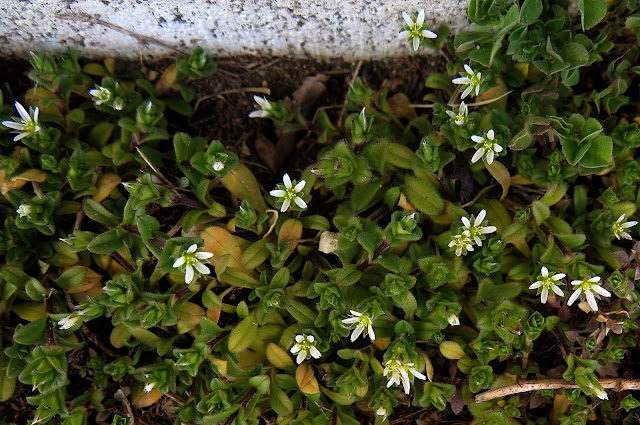Except for a mostly blue sky, it wasn't really very "springlike" last Monday, when my friends Sue and Dana and I celebrated the first day of spring with a walk at Saratoga Spa State Park. The temps were still well below freezing as we walked down the Ferndell Ravine, on our way to toast the new season with waters from some of the park's many natural mineral springs.

(The stone basin pictured here was formerly piped to provide from the city's treated drinking water, not mineral water springing up from the earth. It does not function during the winter.)
A cold wind was channeling down the ravine, but we did pause our hurrying steps long enough to notice some of the trailside plants. This flourishing bank of Plantain-leaved Sedge (Carex plantaginea) was a sign that lime must be one of the minerals in the mineral water, since this evergreen sedge will seldom grow where the soil is not enriched with lime.
Hobblebush (Viburnum lantanoides) is a native shrub that actually likes it cold, and its fully-formed leaf/flower buds defy winter's blasts by the merest of means, the thinnest of flockings. I myself was shivering in my down coat, while these buds (which appeared to be about to open) looked as perky as ever.
Ah, more sunlight waited as we emerged from the shady ravine, bathing the park's picnic area with its warming rays. The water that bubbled up from the first spring we tasted, though, was icy cold, and sparkly with effervescence from its natural carbonation. Refreshing!
Tallulah, the second spring we visited, lies well off the road, but a helpful sign points out its location.
"Tallulah" is a Native American word that means "leaps from the earth," and that is exactly what the waters of the Tallulah Spring do. It was easy to fill our tasting cups from this gentle flow.
Tallulah's water flows across the earth, where exposure to the air oxidizes its iron content and turns its mineral deposits blood red.
That the water of Polaris, the next spring we tasted, is also rich in iron is indicated by the rusty-red of its stone basin. This water "reaches for the stars" as the built-up energy from dissolved gasses forces it up from the earth. We had to time our movements to capture a cup of this dancing water out of the air, without saturating our gloves.
Our next spring, the Hayes Spring, awaited along the banks of Geyser Creek, which was flowing energetically from the melting of a recent heavy snowfall.
The Hayes Spring is said to contain more minerals than any of Saratoga's other springs, and Sue is about to see what this mineral-rich cocktail tastes like. (Our friend Dana was willing to sniff all these waters, but politely declined to sample them.)
I guess the Hayes Spring water was not to Sue's liking! Not really to mine, either, but I did take a sip to honor the occasion.
The next spring awaited us along the trail that follows Geyser Creek. In fact it's this very spring, misnamed "The Geyser," that lent its name to the creek. This spring is actually NOT a geyser (which is a hot spring that acquires its energy from a build-up of geothermal heat), but is rather a "spouter," acquiring its energy from a build-up of cold gasses. We were not able to taste these waters, since access to its "island" is forbidden, in order to prevent the destruction of its "tufa" -- the mound-like accretion of mineral deposits that grows larger as the years go by.
As we walked the trail along the creek, we examined the stone walls and steep banks lining the trail for whatever wintering-over ferns and mosses we could find. The evergreen fern pictured here was an Intermediate Wood Fern (Dryopteris intermedia).
These shriveled remains could still be identified as belonging to Maidenhair Ferns (Adiantum pedatum). This beautiful fern is usually an indicator of lime-rich soil.
Sue examines this moss-covered bank for the presence of liverworts. That an iron-rich mineral-water spring is wetting this bank was made obvious by the reddened streak through the green mossy carpet.
As the sun rose higher, the temperature rose above freezing, but icicles still draped these bank-clinging tree roots where the sun could not reach them.
Dana and Sue stand before the huge tufa that rises along Geyser Creek. This impressive mound of mineral deposits has resulted from the flowing waters of the Orenda Spring high atop the steep bank.
Peering closely at the water-washed dome, we could see the beautiful patterns of built-up calcium deposits as the water shimmered over them.
A set of stairs leads to the top of the bluff, where a small stone house encloses Orenda Spring. The word "Orenda" means a divine force believed by the Iroquois people to be the source of all positive human accomplishment. Wouldn't it be wonderful if all the peoples of the world could be so transformed by drinking the waters of this spring? One could only hope!
Filled with such hope, we filled our cups and toasted the new season with icy-cold effervescent spring water.


















































